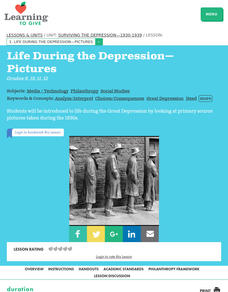National Endowment for the Humanities
Martin Luther King, Jr. and Nonviolent Resistance
Was nonviolent resistance the best means of securing civil rights for black Americans in the 1960s? In this highly engaging and informative lesson, your young historians will closely analyze several key documents from the civil rights...
Curated OER
Hamlet and the Pirates
High schoolers use seventeenth century primary sources to understand the off-stage pirate attack that occurs in Hamlet. Students read and discuss Hamlet's letter to Horatio from the play, Hamlet. High schoolers analyze primary documents...
Curated OER
Surviving the Depression- 1930-1939 Lesson 1: Life During the Depression- Picture
Students examine and analyze primary source documents and pictures from the Great Depression Era. They consider ways in which the suffering of the Era could have been alleviated.
Curated OER
What We Leave Behind
Students analyze primary source documents from the 1830's. They examine how records, memoirs and artifacts preserve history and discuss what should be placed in a time capsule for future generations.
Curated OER
Geography and Its Impact on Colonial Life
Pupils interpret historical evidence presented in primary and secondary resources. In this colonial America lesson, students conduct research to determine how geographic conditions dictated settlement patterns.
Curated OER
Analyzing "A Furious Mob"
In this Stamp Act research worksheet, students examine a copy of "A Furious Mob," (not included) and respond to 6 short answer questions regarding its content.
West Virginia Department of Education
An Act Worthy of Reward
John Brown is considered by many to be a martyr for abolition and civil rights. The resource covers an important event in West Virginian history, the raid by John Brown, as a standalone that discusses Brown's last words and his reaction...
National WWII Museum
Women and the War: Supporting Historical Interpretations
Rosie the Riveter may be an iconic image from World War II, but not all historians agree on how the conflict affected women in the workplace. Individuals evaluate the writings of well-known historians on the topic, and then decide: Was...
Stanford University
Buddhist Monk Protest
What makes the Buddhist Monk Protest a historically significant event? Interested historians use photographic evidence and source information to analyze and explain the importance of the event. The assessment is structured in a short...
Smithsonian Institution
Latino Patriots
Pupils may not be familiar with Bernardo de Gálvez or Juan Seguín, but these Latinx patriots played important roles in American history. Using biographies of the Revolutionary War hero and Texan politician, historians consider how Latinx...
Stanford University
Greensboro Sit-Ins
The Greensboro sit-in was an important event of the Civil Rights Movement, but why? Secondary learners analyze a photo from the sit-in to explain what made the event historically significant. The assessment explains what qualifies as a...
Stanford University
Kent State
Why did a peaceful student protest end in disaster? Young historians explain the impact of the Kent State shooting. Academics analyze a photo of the Kent State shooting and explain the significance of the event by completing short answer...
Stanford University
Soviets in Berlin
High school historians use their knowledge of WWII to analyze a photo of the Soviets entering Berlin. The social studies assessment is comprised of two short answer questions to assess academics' understanding of the historical...
Curated OER
1863: Shifting Tides
The victory at Gettysburg is forever immortalized in the famous speech given by Present Abraham Lincoln. Designed for secondary pupils, an interesting lesson plan explains how 1863 was a pivotal year for the Union. Academics explore the...
PBS
Booker T. Washington: Orator, Teacher, and Advisor
Imagine teaching yourself to read and write—do you think you could do it? Scholars analyze how Booker T. Washington went from a slave learning to read to a leading educator in the United States. Using video clips, speeches, and primary...
Carolina K-12
Early American Settlements
What brought settlers from Europe to North America? By exploring primary sources, such as posters seeking recruits for the new lands, class members take a deeper look at these motivations. To finish, they present their findings to...
Alabama Department of Archives and History
African American Life After the Civil War - Sharecropping
What is the sharecropping system? What role did it play in the post-Civil War economy of the South? Who were the sharecroppers? Who employed them? How were they paid? To answer these questions, kids examine a series of sharecropper...
Curated OER
Civil War Battles: The Reporter's Perspective A WebQuest
Young scholars interpret historical evidence presented in primary and secondary resources. In this research skills instructional activity, students research the job of reporting for new agencies during the American Civil War as they...
Curated OER
The Three Faces of William Penn
Students analyze art depicting William Penn. They analyze three different paintings discussing the symbolism, artistic elements, and depiction of Native Americans in each painting.
Curated OER
The Declaration of Independence: From Rough Draft to Proclamation
Students examine and analyze an unknown document (Jefferson's original rough draught of The Declaration). In this document analysis lesson plan, students compare the rough draught with the first printed version and work in pairs to...
Curated OER
Establishment of Plainfield
Eighth graders analyze documents and maps of Plainfield, CT from different time periods, then, working in a small group, create a map for a giventime. In this Plainfield lesson, 8th graders read primary and secondary sources from local...
Curated OER
The Great Depression: A Study Guide Through Song
Students take a closer look at the political and social outlook during the Great Depression. In this Great Depression lesson plan, students analyze selected songs from the time period. Students use the provided lyric sheets and song...
Curated OER
The Life of a Hoosier Soldier, based on the letters of Lt. John V. Hadley
Eighth graders take a closer look at the life of Union soldiers. In this American Civil War instructional activity, 8th graders read and analyze a series of letters from Lt. John Hadley to his fiancée. Students chart their findings from...
Curated OER
Adventures with Lewis and Clark
Students interpret historical evidence presented in primary and secondary resources. In this Lewis and Clark lesson, students conduct research about the expedition and present their findings to their classmates.

























